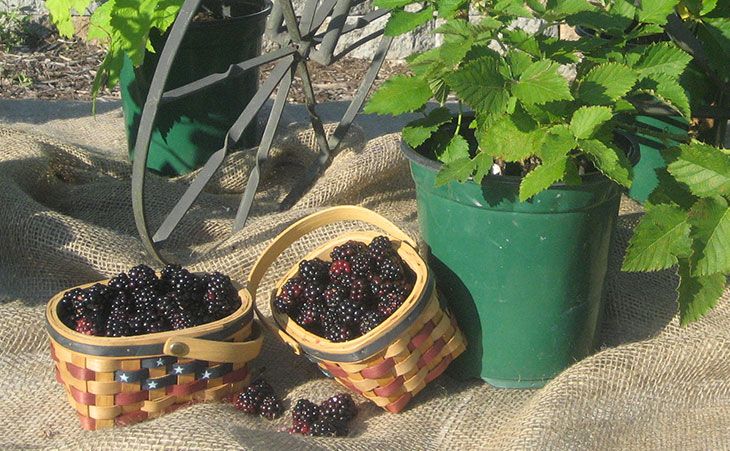Planting Primocanes

Blackberries and raspberries are native to the U.S. and can grow in many different regions. Primocane blackberry and raspberry varieties will produce their fruit on the first year canes, bearing in the fall until frost in most areas.
Care: Planting Primocanes
It's best to plant primocane berry plants in a sunny spot, like along a fence line, which you can use as a vertical support for your blackberry and raspberry canes. Plant in fertile, well-drained soil, and water as needed for the first month to help get them established. After that, no additional water is necessary except in times of drought. Because blackberry and raspberry plants are native to the U.S., they can easily survive on the natural amount of rainfall in your region.
Maintenance: Pruning Primocanes
To have success when you grow primocane-bearing berry plants, proper upkeep is key. A healthy berry patch can even bear fruit for decades! Luckily, primocane berry plants are low-maintenance.
Fall-Bearing Method (1-Crop)
Because primocane-bearing blackberry and raspberry plants yield a fruiting crop on their first-year canes, you may choose to employ the technique of "mowing" your plants down after harvest. This method makes it so that you are only growing first-year canes and getting a fall crop from primocane-fruiting berry plants.
- In late winter, prune all the canes down to the crown (ground level). New shoots will grow in spring.
- These new shoots are the current-season's canes; first-year canes or "primocanes".
- For a more bountiful harvest, once these canes reach 3 feet in height, tip-prune them back.
- Cut 6-12 inches off the tips*. This will encourage more lateral (side) branching – and more potential berries!
- Provide support (tomato cages work nicely!) if canes are leaning.
*Do not prune if you want earlier harvests, or if buds/flowers have already formed on the tip. When using the fall-bearing method of pruning, you can push up the yield time of your blackberries and raspberries by covering them with plastic in early spring. This will create a warmer microclimate around the crown of the plant and will promote earlier growth. Remove the plastic after the last day of frost in your region.
Everbearing Method (2-Crop)
Blackberry and raspberry plants are naturally biennial. This means that the canes only grow for two years then die. The first year's canes are called primocanes and those canes in their second year are called floricanes. Floricanes are vegetative the first year, become fruiting canes that set fruit the following summer, and then they die back after harvest. For multiple harvests...
- going into winter, don't prune all the canes to the crown.
- only prune out the dead or diseased canes to the crown and leave all other canes. This can be done at any time throughout the growing season (unlike tip pruning, which should be done in the summer).
- the floricanes you allow to grow from the previous year will bear fruit in the summer.
- new primocanes will bear fruit in the early fall through the first frost, giving you an extended harvest**.
- after the second-year floricanes have borne fruit, prune them back to the ground. They will die back anyway, making it easy to tell them from the canes to keep.
**Many northern gardeners with short growing seasons may not see a fall crop, even from everbearing varieties. Be sure to choose and plant the type of blackberry or raspberry plants that will perform best in your location!
And remember – regardless of pruning method – when pruning in late winter, mulch around your primocane blackberry and raspberry plants to protect them going into the next growing season. Primocanes are a must for every home gardener, in my opinion!
Popular Primocane Berry Plants:


Prime-Ark® 45 Primocane Blackberry. A very good early primocane blackberry, this is a disease-resistant plant that will produce fruit on the first-year-cane growth. Perfect for zones ranging from 5 to 8.
Erect and high-yielding, you'll harvest large, delicious berries beginning mid-June until the first frost – even on first year canes (primocanes). Great choice for zones 5 through 8.
This primocane-bearing plant delivers a bumper-crop of sweet berries from mid-June through frost, beginning the first year. Vigorous and perfect for zones 5 through 8.
Jaclyn Primocane Red Raspberry. This disease-resistant primocane raspberry plant grows 5-foot-tall canes and thrives in zones 4 through 8. Productive and great for multiple harvests.
Himbo Top™ Primocane Red Raspberry. This high-yielding, disease-resistant raspberry plant is well suited for zones 4 through 8. The large red raspberries tend to weigh down the canes, so consider sturdy vertical supports for your plants.
Shop Primocane Berry Plants:
Guest article by Patti Moreno


